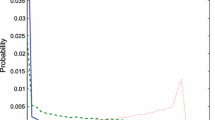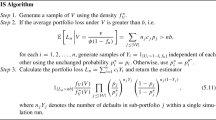Abstract
In this paper, it is analyzed whether a Fourier-based approach can be an efficient tool for calculating risk measures in the context of a credit portfolio model with integrated market risk factors. For this purpose, this technique is applied to a version of the well-known credit portfolio model CreditMetrics, extended by correlated interest rate and credit spread risk. While Fourier-based methods are reported to be superior to full Monte Carlo simulations for default mode models, this result cannot be confirmed for the integrated market and credit portfolio model used here. The application of standard importance sampling techniques for improving the performance of the Fourier-based approach is problematic, too. However, combining the full Monte Carlo simulation with an importance sampling technique indeed yields superior results, even for the integrated market and credit portfolio model.




Similar content being viewed by others
Notes
An exception is the approach Algo Credit developed by the risk management firm Algorithmics (see Iscoe et al. 1999).
Furthermore, an application of the Fourier-based approach to the analysis of asset-backed securities and collateralized debt obligations can be found in Debuysscher and Szegö (2003).
Using moment generating functions, Finger (1999) describes a similar approach for the original CreditMetrics framework without market risk.
For details concerning this procedure, see Gupton et al. (1997, p 85).
In the Vasicek model, the short rate at the risk horizon is normally distributed and can be represented by \(r{\left( t \right)} = \theta + {\left( {r{\left( 0 \right)} - \theta } \right)}e^{{ - \kappa t}} + {\sqrt {{\sigma ^{2}_{r} {\left( {1 - e^{{ - 2\kappa t}} } \right)}} \mathord{\left/ {\vphantom {{\sigma ^{2}_{r} {\left( {1 - e^{{ - 2\kappa t}} } \right)}} {{\left( {2\kappa } \right)}X_{r} }}} \right. \kern-\nulldelimiterspace} {{\left( {2\kappa } \right)}X_{r} }} }\,\,{\left( {X_{r} \; \sim \;N{\left( {0,1} \right)};\;\kappa ,\theta ,\sigma \in \mathbb{R}_{ + } } \right)}.\)
For simplicity, it is assumed that all defaultable zero coupon bonds have the same time to maturity T n =T.
For example, Barnhill and Maxwell (2002) estimate a short rate volatility of 0.007, whereas Lehrbaß (1997) finds σ r =0.029 and Huang and Huang (2003) even work with σ r =0.0468. With regard to the mean reversion parameter and the market price of interest rate risk, Lehrbaß finds κ=1.169 and absolute values of 0.59, 0.808, and 1.232 for the parameter λ, whereas Huang and Huang choose κ=0.226 and an absolute value of 0.248 for λ.
The grid points and weights of the Gauss–Legendre integration rule for n=96 are taken from Abramowitz and Stegun (1984, p 397). The length of the intervals on which the Gaussian integration is applied increases because, for rising values of t, the absolute value of the oscillating integrand decreases rapidly. Alternatively, the trapezoidal rule has been tried for computing Eq. 3. However, due to the larger number of grid points needed by this numerical integration rule, the performance of the Fourier-based approach gets worse.
However, in general, the number of exposure buckets will also increase when the number of obligors increases (see the comment later in this section). In Merino and Nyfeler’s approach, the number N of obligors has an influence on the dimension of the discrete Fourier transforms of the conditional loss distribution of each exposure bucket and, hence, on the number of component-wise complex multiplications needed to determine the discrete Fourier transform of the conditional portfolio loss distribution.
Binnenhei (2004) proposes an analytic extension of the CreditRisk+ model, which incorporates rating transitions. In his approach, all proper transition probabilities are approximated by a Poisson distribution. Aside from the problem that, with this approximation, multiple credit events of single obligors can occur in all possible combinations, one necessary condition to apply his approach is that there are no value changes when the obligor does not change its initial rating. However, this prerequisite is not fulfilled within the integrated market and credit portfolio model because, even given that an obligor maintains his initial rating, the exposures are stochastic due to the market risk.
The meaning of “similar” is concretized by the definition of a so-called basic loss unit. The losses of all exposure buckets are an integer multiple of this basic loss unit, and the exposure buckets only differ in the value of the multiple.
See Merino and Nyfeler (2002, p 83).
For the ease of exposition, it is assumed that the random vector (Z,X) is multivariate normally distributed.
For a more detailed discussion of this approach when applied to integrated market and credit portfolio models, see Grundke (2006).
Alternatively, to save computation time, one set of IS means could be used for the estimation of all percentiles corresponding to “higher” confidence levels. Glasserman and Li (2005) report that the variance reduction effect is relatively insensitive with respect to the IS means. For the simulation results reported in Tables 7 and 8, the exact percentile estimators for each confidence level are used for determining the IS means for the systematic risk factors Z and X r .
Other papers, which apply variance reduction techniques to Monte Carlo simulations in a credit risk context, are from Joshi (2004), Joshi and Kainth (2004), Kalkbrener et al. (2004), Merino and Nyfeler (2004), Morokoff (2004), Tchistiakov et al. (2004), Egloff et al. (2005), Rott and Fries (2005), Bassamboo et al. (2006), and Glasserman (2006).
References
Abramowitz M, Stegun IA (eds) (1984) Pocketbook of mathematical functions, abridged edition of handbook of mathematical functions. (Material selected by Danos M, Rafelski J) Frankfurt aM
Barnhill TM Jr, Maxwell WF (2002) Modeling correlated market and credit risk in fixed income portfolios. J Bank Financ 26:347–374
Barth J (2000) Worst-case analysis of the default risk of financial derivatives considering market factors (in German). Hamburg
Basel Committee on Banking Supervision (2005) International convergence of capital measurement and capital standards. A revised framework. Basel
Bassamboo A, Juneja S, Zeevi A (2006) Portfolio credit risk with extremal dependence: asymptotic analysis and efficient simulation. Working paper, Stanford University, Tata Institute of Fundamental Research and Columbia University
Binnenhei C (2004) An analytic approach to rating transitions. In: Gundlach M, Lehrbaß F (ed) CreditRisk+ in the banking industry. Springer, Berlin Heidelberg New York, pp 187–214
Davies RB (1973) Numerical inversion of a characteristic function. Biometrika 60(2):415–417
Debuysscher A, Szegö M (2003) The Fourier transform method—technical document. Moody’s Investors Service, New York
De Munnik JFJ (1996) The valuation of interest rate derivative securities. Routledge, London
Duffie D, Pan J (2001) Analytical value-at-risk with jumps and credit risk. Finance Stoch 5(2):155–180
Egloff D, Leippold M, Jöhri S, Dalbert C (2005) Optimal importance sampling for credit portfolios with stochastic approximation. Working paper, Zürcher Kantonalbank and Swiss Banking Institute, University of Zürich
Eom YH, Helwege J, Huang J-Z (2004) Structural models of corporate bond pricing: an empirical analysis. Rev Financ Stud 17(2):499–544
Finger CC (1999) Conditional approaches for CreditMetrics portfolio distributions. CreditMetrics Monitor, April, 14–33
Frye J (2000) Collateral damage. Risk, April, 91–94
Frye J (2003) A false sense of security. Risk, August, 63–67
Gil-Pelaez (1951) Note on the inversion theorem. Biometrika 38:481–482
Glasserman P (2004) Monte Carlo methods in financial engineering. Springer, Berlin Heidelberg New York
Glasserman P (2006) Measuring marginal risk contributions in credit portfolios. J Comput Financ 9(2):1–41
Glasserman P, Li J (2005) Importance sampling for portfolio credit risk. Manage Sci 51(11):1643–1656
Glasserman P, Heidelberger P, Shahabuddin P (1999) Asymptotically optimal importance sampling and stratification for pricing path-dependent options. Math Financ 9(2):117–152
Gordy M (2000) A comparative anatomy of credit risk models. J Bank Financ 24(1–2):119–149
Grundke P (2004) Integrating interest rate risk in credit portfolio models. J Risk Financ 5(2):6–15
Grundke P (2005) Risk measurement with integrated market and credit portfolio models. J Risk 7(3):63–94
Grundke P (2006) Importance sampling for integrated market and credit portfolio models. Working Paper, Department of Banking, University of Cologne
Gupton GM, Finger CC, Bhatia M (1997) CreditMetrics—technical document. New York
Huang J-Z, Huang M (2003) How much of the corporate-treasury yield spread is due to credit risk? Working Paper, Penn State University, New York University, and Stanford University
Iscoe I, Kreinin A, Rosen D (1999) An integrated market and credit risk portfolio model. Algorithmics Research Quarterly 2(3):21–38
Jarrow RA, Turnbull SM (1995) Pricing derivatives on financial securities subject to credit risk. J Finance 50(1):53–85
Jarrow RA, Lando D, Turnbull SM (1997) A Markov model for the term structure of credit risk spreads. Rev Financ Stud 10(2):481–523
Joshi MS (2004) Applying importance sampling to pricing single tranches of CDOs in a one-factor Li model. Working Paper, QUARC, Group Risk Management, Royal Bank of Scotland
Joshi MS, Kainth D (2004) Rapid computation of prices and Greeks for nth to default swaps in the Li Model. Quantitative Finance 4(3):266–275
Kalkbrener M, Lotter H, Overbeck L (2004) Sensible and efficient capital allocation for credit portfolios. Risk, Special Report Credit Risk, January, 19–24
Kiesel R, Perraudin W, Taylor A (2003) The structure of credit risk: spread volatility and ratings transitions. J Risk 6(1):1–27
Kijima M, Muromachi Y (2000) Evaluation of credit risk of a portfolio with stochastic interest rate and default processes. J Risk 3(1):5–36
Klein P (1996) Pricing Black-Scholes options with correlated credit risk. J Bank Financ 20(7):1211–1229
Klein P, Inglis M (2001) Pricing vulnerable European options when the option’s payoff can increase the risk of financial distress. J Bank Financ 25(5):993–1012
Lehrbaß F (1997) Defaulters get intense. Risk, Credit Risk Supplement, July, 56–59
Longstaff F, Schwartz E (1995) A simple approach to valuing risky fixed and floating rate debt. J Finance 50(3):789–819
Lyden S, Saraniti D (2000) An empirical examination of the classical theory of corporate security valuation. Working Paper, Bourne Lyden Capital Partners and Barclays Global Investors, San Francisco
Merino S, Nyfeler M (2002) Calculating portfolio loss. Risk, August, 82–86
Merino S, Nyfeler M (2004) Applying importance sampling for estimating coherent credit risk contributions. Quantitative Finance 4(2):199–207
Moody’s Investors Service (1996) Corporate bond defaults and default rates 1938–1995. Special comment, New York
Moody’s Investors Service (2002) Default and recovery rates of corporate bond issuers. A statistical review of Moody’s ratings performance 1970–2001. Special Comment, New York
Morokoff WJ (2004) An importance sampling method for portfolios of credit risky assets. In: Ingalls RG, Rossetti MD, Smith JS, Peters BA (eds) Proceedings of the 2004 Winter Simulation Conference, pp 1668–1676
Pykhtin M (2003) Unexpected recovery risk. Risk, August, 74–78
Reiß O (2003) Mathematical methods for the efficient assessment of market and credit risk. Ph.D. thesis, Department of Mathematics, University of Kaiserslautern
Rott MG, Fries CP (2005) Fast and robust Monte Carlo CDO sensitivities and their efficient object oriented implementation. Working Paper
Rouvinez C (1997) Going Greek with VaR. Risk, February, 57–65
Stuart A, Ord K (1994) Kendall’s advanced theory of statistics, vol I, Distribution theory. 6th edn, London
Tchistiakov V, de Smet J, Hoogbruin P-P (2004) A credit loss control variable. Risk, July, 81–85
Vasicek OA (1977) An equilibrium characterization of the term structure. J Financ Econ 5(2):177–188
Acknowledgements
I wish to thank Rosalind Bennett, Marc Gürtler, and two anonymous referees for their helpful comments. For stimulating discussions, I also thank the participants of the Global Finance Conference in Dublin 2005, the Annual Meeting of the European Financial Management Association in Milan 2005, the International Conference on Finance in Copenhagen 2005, the International Scientific Annual Conference Operations Research in Bremen 2005, the Annual Meeting of the German Finance Association in Augsburg 2005, and the Annual Meeting of the Financial Management Association in Chicago 2005.
Author information
Authors and Affiliations
Corresponding author
Additional information
A previous version of this paper was entitled “Application of Fourier inversion methods to credit portfolio models with integrated interest rate and credit spread risk”.
Rights and permissions
About this article
Cite this article
Grundke, P. Computational aspects of integrated market and credit portfolio models. OR Spectrum 29, 259–294 (2007). https://doi.org/10.1007/s00291-006-0050-7
Published:
Issue Date:
DOI: https://doi.org/10.1007/s00291-006-0050-7
Keywords
- Credit risk
- Interest rate risk
- Credit spread risk
- Credit portfolio model
- Value at risk
- Characteristic function
- Fourier transforms




